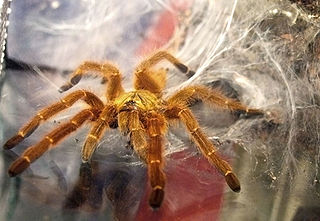
Ant spiders are members of the family Zodariidae. They are small to medium-sized eight-eyed spiders found in all tropical and subtropical regions of South America, Africa, Madagascar, Australia-New Guinea, New Zealand, Arabia and the Indian subcontinent. Most species are daytime hunters and live together with ants, mimicking their behavior and sometimes even their chemical traits. Although little is known about most zodariids, members of the genus Zodarion apparently feed only on ants; a number of other genera in the family are apparently also ant specialists.

Liocranidae is a family of araneomorph spiders first described by Eugène Simon in 1897. They are one of several groups called "sac spiders". The holarctic genus Agroeca is the best-known, but it also includes various genera of more obscure spiders that still lack a diagnosis. Two species in the North American genus Neoanagraphis are found in the extremely dry conditions in the Mojave, Sonoran and Chihuahuan deserts. Females live in animal burrows while males wander and are the ones most often caught in pitfall traps.
Palfuria is a spider genus of the family Zodariidae of which nine species from Africa have been described to date.

Heliophanus is a genus of the spider family Salticidae. Most of the almost 170 described species occur in Africa, with many others found in the Palearctic region from Europe to Japan.

Mexcala is a genus of jumping spiders that was first described by George and Elizabeth Peckham in 1902. The name is probably derived from the Nahuatl mezcal.

The Harpactirinae are a subfamily of tarantulas which are native to the continent of Africa. Like many Old World tarantulas, they have a relatively strong venom, and can inflict a painful bite.

Smeringopus is a genus of cellar spiders that was first described by Eugène Louis Simon in 1890.
Hermippus is a genus of ant eating spiders in the family Zodariidae, containing twelve species restricted to Asia and parts of Africa. Three new species were discovered in 2014.
Ibala is a genus of African ground spiders that was first described by M. J. FitzPatrick in 2009.
Theuma is a genus of African long-spinneret ground spiders that was first described by Eugène Louis Simon in 1893.It was transferred to the ground spiders in 2018, then returned in 2022.
Caesetius is a genus of spiders in the family Zodariidae. It was first described in 1893 by Simon. As of 2017, it contains 10 species from southern Africa.
Cydrela is a genus of spiders in the family Zodariidae. It was first described in 1873 by Thorell. As of 2022, it contains 17 species from a variety of places in Asia and Africa.
Heradida is a genus of spiders in the family Zodariidae. It was first described in 1893 by Simon. As of 2017, it contains 7 African species.
Systenoplacis is a genus of spiders in the family Zodariidae. It was first described in 1907 by Simon. As of 2017, it contains 22 African species.
Diores is a genus of spiders in the family Zodariidae.
Hemiblossia is a genus of daesiid camel spiders, first described by Karl Kraepelin in 1899.
Biton is a genus of daesiid camel spiders, first described by Ferdinand Karsch in 1880.





